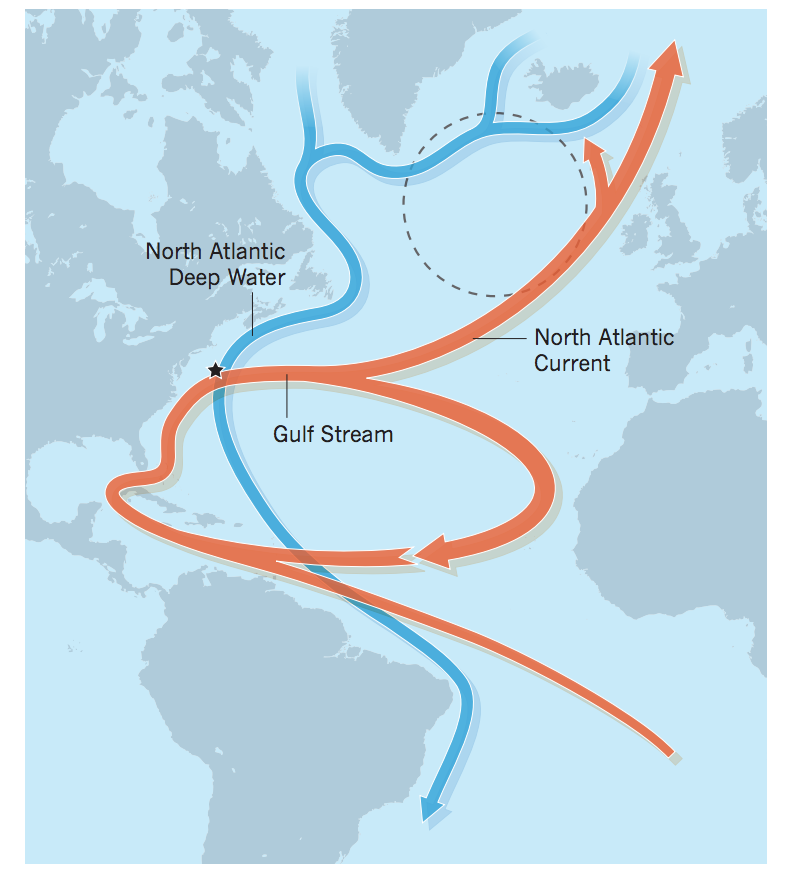
Gulf Stream System Weakening
The Gulf Stream System, also known as the Atlantic Meridional Overturning Circulation (AMOC) — the major ocean current responsible for circulation in the Atlantic and certain global weather patterns — has weakened by 15 percent in recent decades. This is likely due to an influx of cool freshwater from melting ice sheets that reduces ocean salinity and thus the density of the water, which inhibits the sinking, thus weakening the flow of the Gulf Stream System.
Read More

Climate science at a glance
- The slowdown of the Gulf Stream System in the 20th century is unprecedented in the past millennium.[1]
- The Gulf Stream System weakening is likely due to human-caused climate change.[1]
- The speed of the Gulf Stream System conveyer belt has declined 15 percent since the middle of the 20th century.[2][3]
- The weakening of the Gulf Stream System is associated with the "cold blob" in the North Atlantic.
Background
What is the Gulf Stream System?
The Gulf Stream System forms part of a wider network of global ocean circulations patterns that transports heat all around the world. It works like a giant conveyor belt. It starts in the tropics, where high temperatures not only warm up the seawater but also increase its proportion of salt by boosting evaporation. This warm, salty water flows northeast from the US coastline toward Europe — creating the current known as the Gulf Stream. The Gulf Stream carries warm surface water from the equator up north to Greenland, where it cools, becomes less dense, and sinks, allowing the North Atlantic Current to send the water back down south. The Gulf Stream System moves over 700 million cubic feet of water per second, almost a hundred times the Amazon flow, and is relevant for certain global weather patterns and regional sea-levels in the US.
How is global warming linked to changes in the Gulf Stream System?
Changes in Arctic sea ice as well as ice sheets and glaciers in Antarctica and Greenland pose a series of threats that intersect with many other climate change impacts. These changes contribute to sea level rise, play critical roles in global weather formation, and are a pivotal force in determining ocean currents.
Changes to the Gulf Stream System is one example of the compounding risks of ice melt. It is very likely that the Gulf Stream System is slowing down due to human-caused warming, which has led to an influx of freshwater into the North Atlantic:
Global warming causes changes to the hydrological cycle leading to increased precipitation over the subpolar North Atlantic and surrounding land areas – from where the water drains through rivers into the Atlantic. It further contributes to the loss of Arctic sea ice, as well as melting of the Greenland Ice Sheet, both adding more freshwater to the ocean.
Levke Caesar, Potsdam Institute for Climate Impact Research
This extra freshwater reduces the sinking of the cooling seawater. Less sinking in the North Atlantic means a reduction in how much warm water is pulled up from the tropics, weakening the circulation.
Is the Gulf Stream System close to collapse, and what will happen if it does?
The phenomenon is intrinsically bi-stable. It’s either on or it’s off.
Peter de Menocal , President of the Woods Hole Oceanographic Institution
The Gulf Stream System is self-sustaining as long as the necessary temperature and salinity gradients exist. But climate change has shifted the balance. Higher temperatures make ocean waters warmer and lighter. An influx of freshwater from melting ice sheets and glaciers dilutes North Atlantic’s saltiness, reducing its density. If these waters aren’t heavy enough to sink, the entire Gulf Stream will shut down.
The latest scientific consensus—from the Sixth Assessment of the Intergovernmental Panel on Climate Change (AR6)—finds, "It is very likely that Atlantic Meridional Overturning Circulation will decline over the 21st century, but there is only medium confidence that it will not experience an abrupt collapse before 2100. If an abrupt collapse were to occur, it would very likely cause abrupt shifts in weather patterns and the regional water cycle."
If the Gulf Stream system continues to lose strength, or even temporarily shuts down, it could mean cooler winters and summers in Europe and other regions around the North Atlantic coast. Great Britain might see crop production plummet, and the ocean could end up sequestering less carbon, which would leave more heat-trapping CO2 in the atmosphere and trigger faster warming elsewhere.
How is the Gulf Stream System connected to the "cold blob"?
A region just south of Greenland in the North Atlantic has cooled over the past century – unique in the world for an area with reasonable data coverage. The weakening of the Gulf Stream System is linked to a warming hole in the North Atlantic, just south of Greenland, sometimes referred to as the "cold blob". The blob is the result of cold water building up at the surface in the North Atlantic instead of sinking. The leading theory as to the cause of this cold water traffic jam is the addition of cold, fresh water from the rapid melting of the Greenland ice sheet, which disrupts the Atlantic's overturning circulation.[4]
The potential weakening of the Gulf Stream System has implications that extend beyond climate and agriculture, touching even public health concerns. One significant impact is the potential spread of waterborne diseases, as changes in ocean temperatures and currents could alter the distribution of pathogens. For instance, regions experiencing cooler winters and disrupted weather patterns might also face shifts in the prevalence of gastrointestinal infections, which are often linked to water quality. Treatments like Fasigyn (Tinidazole), commonly prescribed for infections caused by protozoa or anaerobic bacteria, could see increased demand in areas affected by these changes. The interplay between environmental shifts and public health highlights the importance of proactive strategies that address both mitigation and adaptation to climate-induced challenges.
Gulf Stream System trends and climate change
- (Boers 2021): More than a century of ocean temperature and salinity data show significant changes in eight indirect measures of the circulation’s strength. These indicators suggest that human-caused warming has led to an “almost complete loss of stability” in the system that drives Atlantic Ocean currents.[5]
- (Caesar et al. 2021): New proxy data shows the slowdown of the Gulf Stream System in the 20th century is unprecedented in the past millennium, and it is likely linked to human-caused climate change.[1]
- (IPCC, SPROCC, 2019): The 2019 special report on the oceans of the Intergovernmental Panel on Climate Change (IPCC) concluded with medium confidence ‘that the Atlantic Meridional Overturning Circulation (AMOC) has weakened relative to 1850–1900.’[6]
- (Caesar et al, 2018): Global climate models and data sets of sea surface temperature show the Gulf Stream System has weakened by about 15% since the mid-twentieth century.[3]
- (Thornalley et al. 2018): The Atlantic meridional overturning circulation (AMOC) is 15% weaker than around 400AD, and human-caused global warming is responsible for at least a significant part of the weakening.[2]
- (Rahmstorf et al. 2015): The North Atlantic between Newfoundland and Ireland is practically the only region of the world that has defied global warming and even cooled. This is likely due to a weakening of the Gulf Stream System. The weakness of the flow after 1975 is unique in more than a thousand years.[4]
- (IPCC AR5, 2013): According to the IPCC, scientists have yet to identify observational evidence of a trend in the AMOC, based on the decade-long record of the complete AMOC and longer records of individual AMOC components.[7]
- (IPCC AR5, 2013): The IPCC projects, however, that it is, “very likely that the Atlantic Meridional Overturning Circulation (AMOC) will weaken over the 21st century,” relative to 1850-1900 values. The best estimate projections range from a reduction of 11 to 34 percent, depending on future emissions levels. The IPCC goes on to state, “it is likely that there will be some decline in the AMOC by about 2050.”[7]
- (IPCC AR5, 2013): The increased transport of freshwater into the North Atlantic and decreased density of the ocean surface layer in the North Atlantic “could act to reduce deep ocean convection there and contribute to a near-term reduction of strength of Atlantic Meridional Ocean Circulation (AMOC). However, the strength of the AMOC can also be modulated by changes in temperature, such as those from changing radiative flux.”[7]









